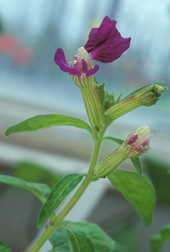This page has been archived and is being provided for reference purposes only. The page is no longer being updated, and therefore, links on the page may be invalid.
Read the magazine story to find out more. |
|
Reheating Cuphea Seed Improves Germination
By Laura McGinnisJuly 10, 2006
The challenge of germinating oil-rich seeds after they've been stored in low temperatures is being met by Agricultural Research Service (ARS) scientists in Fort Collins, Colo.
Cuphea is a genus of herbaceous annual plants that grow throughout the Western Hemisphere. Many Cuphea species' seeds yield oils with useful commercial properties, but the lauric and myristic fatty acids which make them marketable can impede their germination following cold storage.
Because lauric and myristic fatty acids have 12 and 14 carbons, respectively, the lipids containing these acids crystallize when stored at 0 degrees Fahrenheit, the standard temperature for long-term seed preservation. When returned to room temperature, the lipids remain crystallized and the seeds usually don't germinate.
Plant physiologist Christina Walters and her colleagues in the ARS Plant Germplasm Preservation Research Unit suspect that freezing temperatures disrupt the forces binding the contents within the seeds' cells, so they cannot function properly when the seeds rehydrate.
With support from ARS researchers in Ames, Iowa, the team examined the seeds' lipid composition, identified the species susceptible to damage, and developed a solution: warming the seeds before germination.
Cuphea seeds can be harvested, dried and stored like other seeds. But before germination, they should be heated for 10 minutes at 113 degrees Fahrenheit. Seeds which have undergone cold storage and reheating are capable of germination, although electron micrograph images show significant differences between post- and pre-storage seeds.
The researchers believe their findings can be used to improve long-term seed storage for other oil-rich tropical species, such as coffee, papaya, citrus and oil palm. This discovery will enable genebanks to better preserve the genetic diversity of these species for future breeding programs.
Read more about the research in the July 2006 issue of Agricultural Research magazine.
ARS is the U.S. Department of Agriculture's chief scientific research agency.

